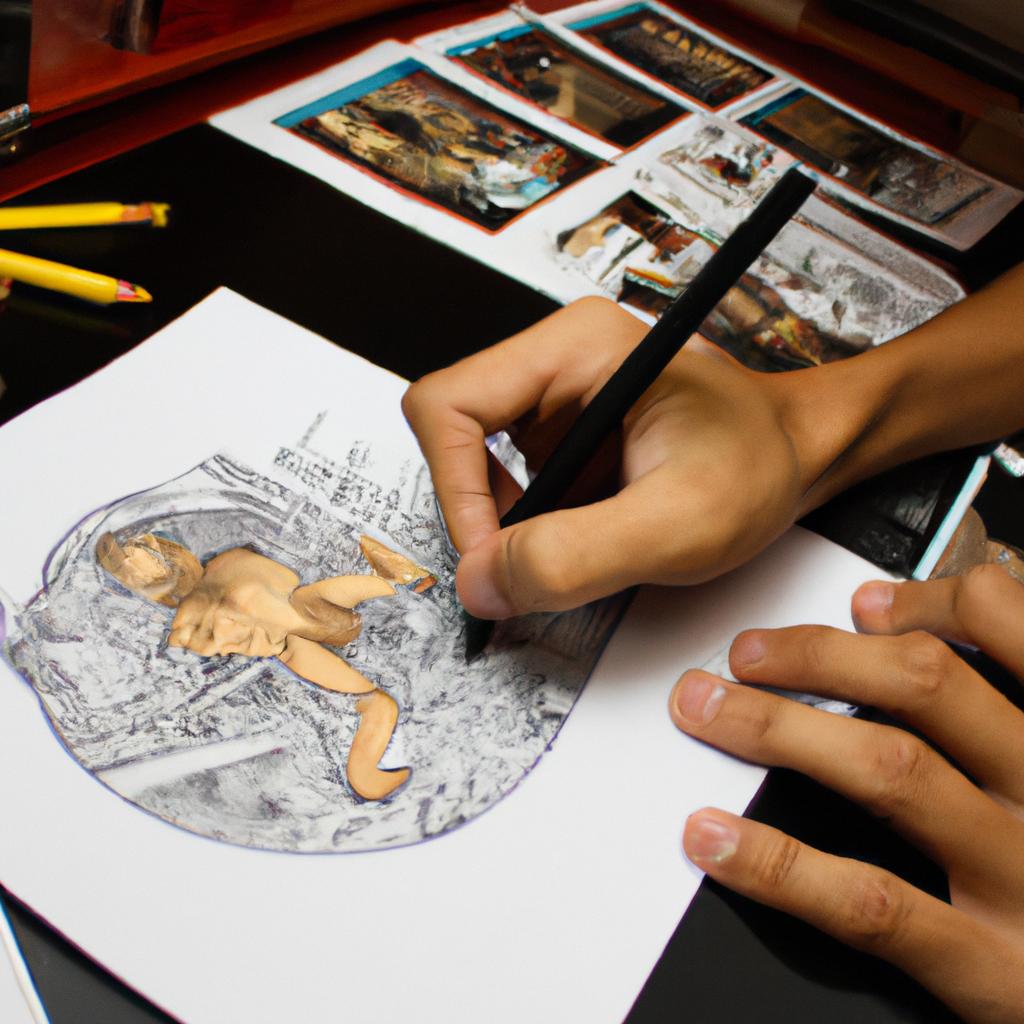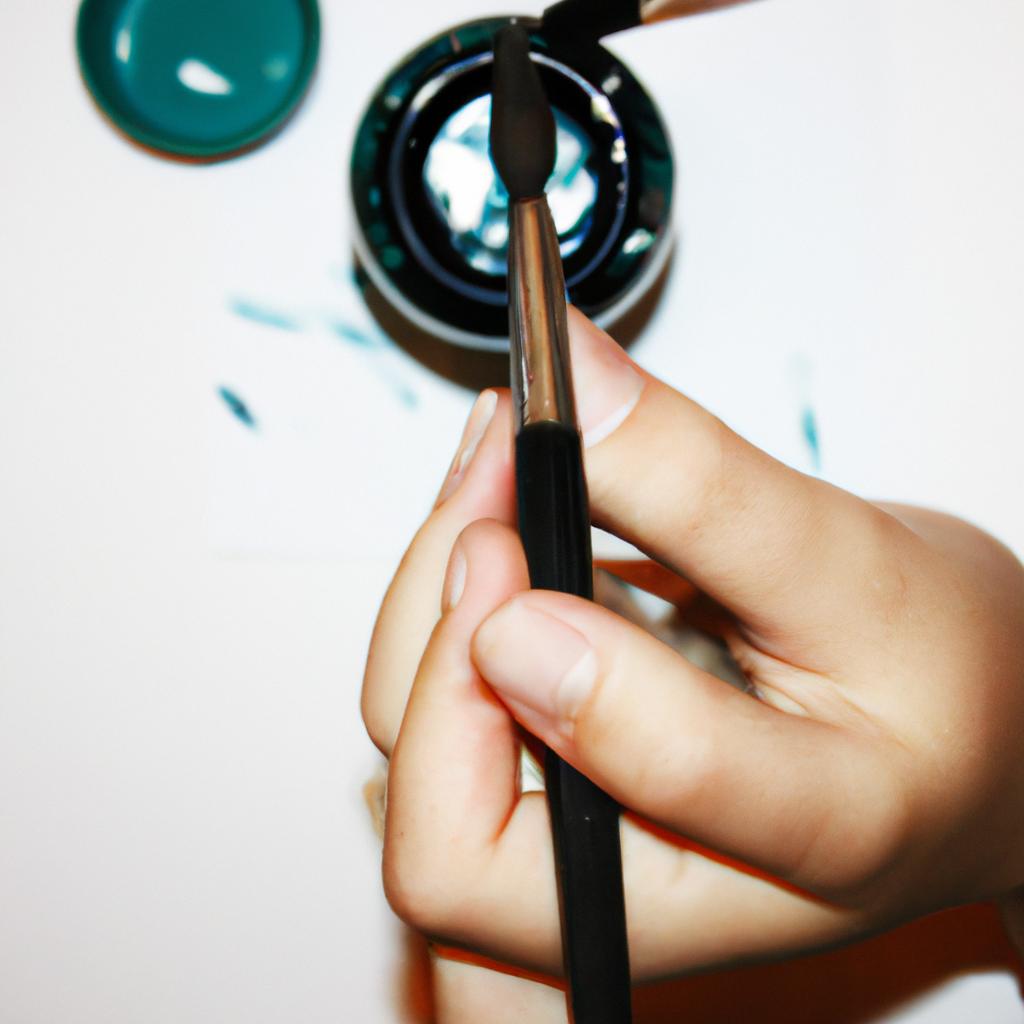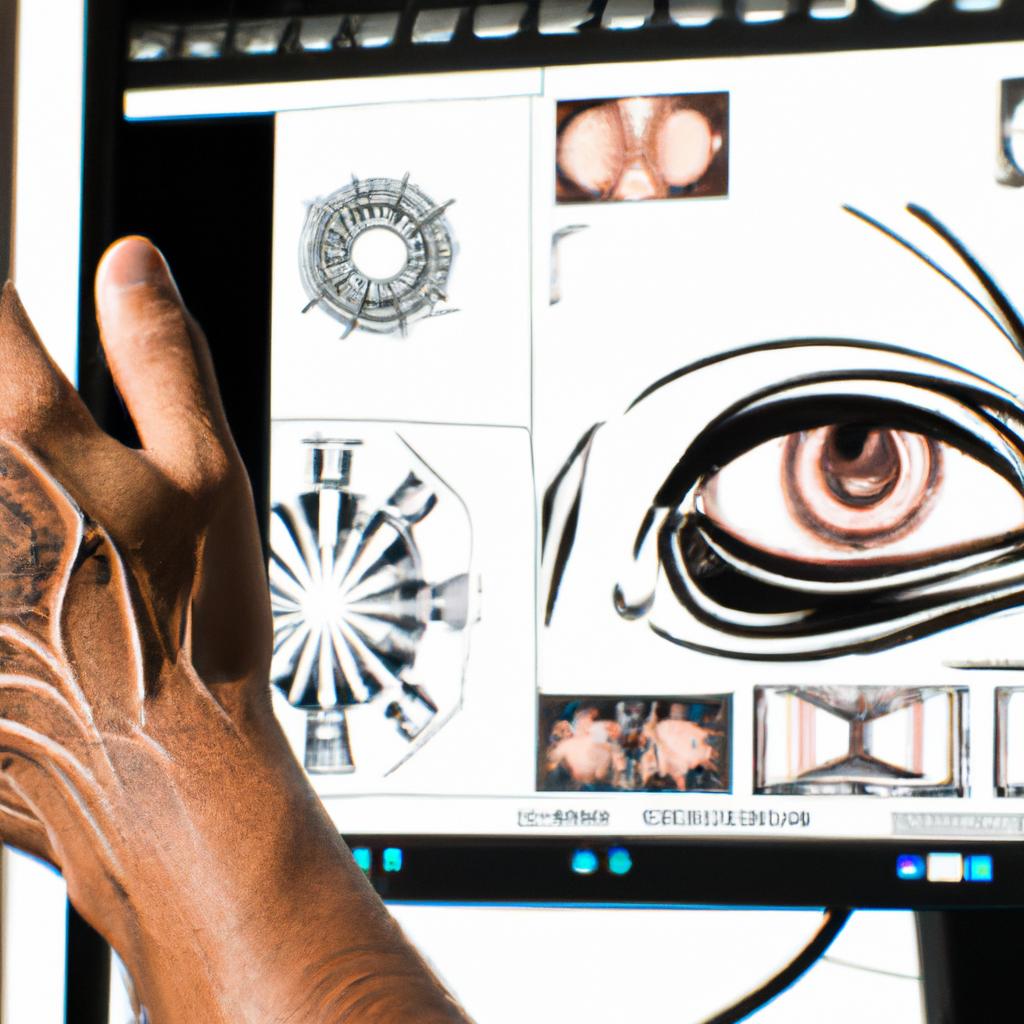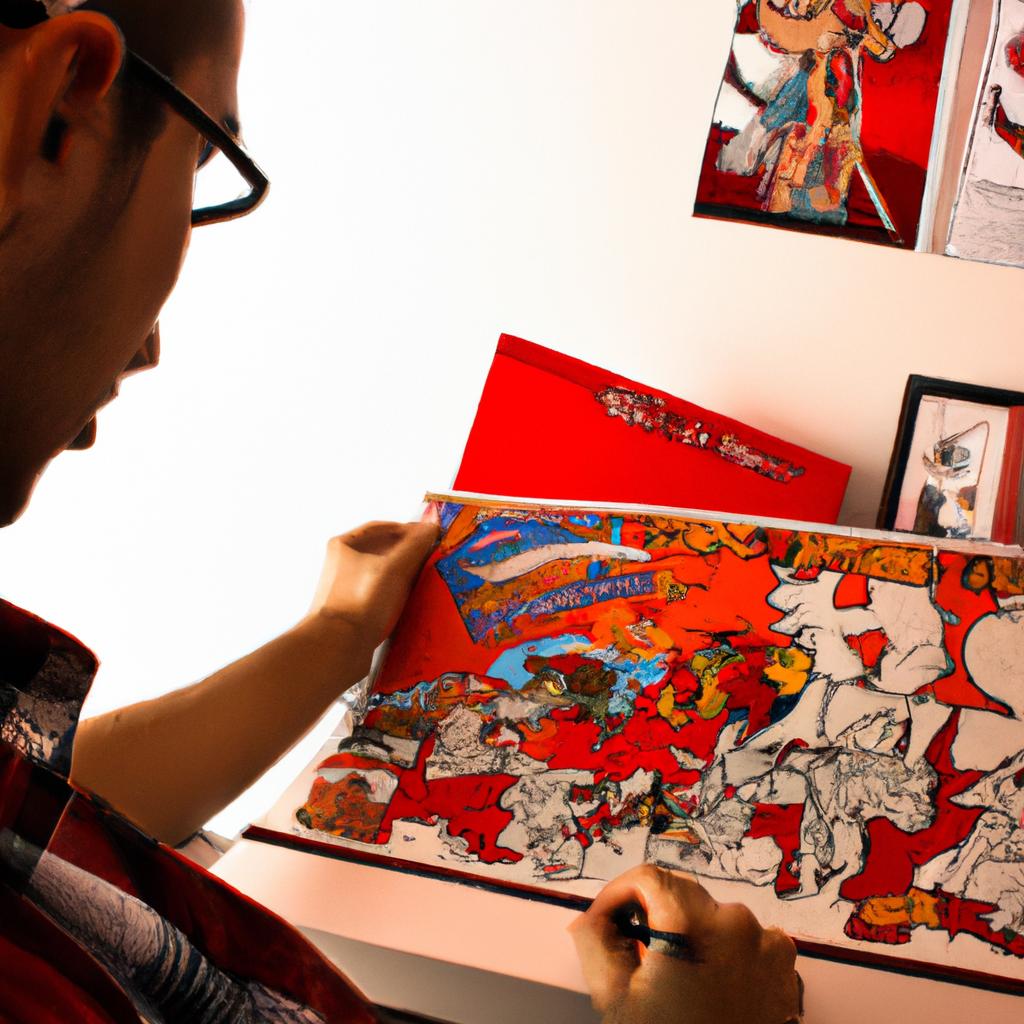Panel layout is a fundamental aspect of comic book art that significantly contributes to the overall impact and storytelling experience. By strategically arranging panels on a page, artists can effectively convey emotions, actions, and narratives in a visually engaging manner. This article explores the importance of panel layout in maximizing the impact of comic book art through an examination of various techniques employed by renowned artists.
To illustrate the significance of panel layout, let us consider the work of acclaimed artist Jack Kirby. In his iconic comic series “The Fantastic Four,” Kirby masterfully employs dynamic panel layouts to capture the intensity and excitement of superhero action. One notable example is seen in issue #1, where Kirby uses irregularly shaped panels with bold angles and overlapping borders to depict the team’s battle against their arch-nemesis, Doctor Doom. Through this creative use of panel layout, Kirby amplifies the sense of chaos and urgency within the scene while immersing readers into the heart-pounding world of superheroes.
By delving deeper into different techniques employed by artists like Kirby, this article will shed light on how specific choices regarding panel size, shape, arrangement, gutters (the space between panels), and transitions contribute to enhancing visual storytelling in comics. Understanding these principles not only allows aspiring comic book artists to create more impactful and engaging artwork, but also helps readers appreciate the thought and intention behind every panel.
One crucial aspect of panel layout is the size and shape of individual panels. Artists often vary panel sizes to emphasize certain moments or actions within a story. For example, larger panels can be used to highlight significant events or dramatic reveals, while smaller panels may be employed for quick action sequences or subtle character interactions. By strategically manipulating panel size, artists can direct the reader’s attention and guide them through the narrative with precision.
The arrangement of panels on a page also plays a vital role in storytelling. Artists carefully consider the pacing and flow of a scene when determining how to position their panels. Sequentially arranging panels from left to right and top to bottom is the most common approach as it aligns with the natural reading order in many cultures. However, artists can deviate from this conventional structure by employing unconventional panel placements, such as overlapping or staggered panels. These techniques inject dynamism into the storytelling process, creating visual interest and guiding readers’ eyes across the page in unique ways.
Gutters, the empty spaces between panels, are another essential element of panel layout. The width of gutters influences the rhythm and pacing of a comic book page. Narrow gutters create a fast-paced reading experience, where one panel swiftly transitions into another without interruption. On the other hand, wider gutters slow down the pace, allowing readers to pause and absorb each panel before moving on. Skilled artists utilize gutter widths strategically to control the tempo of their stories and evoke specific emotions.
Transitions between panels are crucial for seamless storytelling within comics. There are various types of transitions that artists can employ to connect different moments or actions: moment-to-moment, action-to-action, subject-to-subject, scene-to-scene, and aspect-to-aspect transitions. Each type serves distinct purposes; for example, moment-to-moment transitions emphasize incremental changes within a scene, while scene-to-scene transitions transport readers to different locations or timeframes. By carefully selecting and executing transitions, artists can create smooth narrative flow and enhance the overall reading experience.
In conclusion, panel layout is a fundamental aspect of comic book art that significantly contributes to visual storytelling. Artists use various techniques such as panel size, shape, arrangement, gutters, and transitions to maximize impact and engage readers. By understanding these principles and studying the work of renowned artists like Jack Kirby, aspiring comic book artists can elevate their craft and create compelling narratives that captivate audiences.
Understanding panel composition
Understanding Panel Composition
One of the fundamental aspects of creating impactful comic book art lies in the thoughtful arrangement and composition of panels. By strategically positioning and organizing panels on a page, artists can guide readers through the narrative with clarity and enhance the overall visual experience. To illustrate this point, let’s consider an example: a thrilling action sequence where a superhero is battling multiple villains in different locations.
To maximize the impact of such a scene, panel composition plays a crucial role. Firstly, utilizing various panel shapes and sizes can help create dynamic visuals that reflect the intensity of the battle. For instance, larger panels may be used to showcase dramatic moments like powerful punches or explosions, while smaller panels can capture quick movements or close-up details of characters’ expressions. This diversity not only adds visual interest but also allows for effective storytelling by emphasizing important elements within each frame.
Secondly, establishing a clear flow between panels is vital for maintaining coherence throughout the story. By using directional cues such as arrows or lines, artists can lead readers’ eyes smoothly from one panel to another, ensuring seamless transitions between actions or locations. This technique helps prevent confusion and ensures that readers are able to follow the narrative progression effortlessly.
Moreover, strategic placement of panels can create visual tension and emphasize key moments. Placing pivotal scenes at central positions on a page draws immediate attention and intensifies their significance within the story. Additionally, arranging panels asymmetrically rather than following strict grids can add dynamism and energy to the artwork.
In summary, understanding panel composition is essential for maximizing impact in comic book art. By employing diverse panel shapes and sizes, facilitating smooth flow between panels, and strategically placing them for heightened effect, artists can captivate readers and elevate their storytelling capabilities. In our next section about “Utilizing Different Panel Shapes and Sizes,” we will explore specific techniques that further enhance these principles without restricting artistic freedom or creativity
Utilizing different panel shapes and sizes
Transitioning from the concept of understanding panel composition, let us now explore how different panel shapes and sizes can be effectively utilized to enhance the impact of comic book art. By employing varied layouts, artists have the ability to create visually engaging narratives that captivate readers.
For instance, consider a hypothetical case where a comic artist wants to convey a sense of chaos and urgency in a climactic action sequence. In this scenario, they could use irregularly shaped panels with jagged edges and overlapping elements to mimic the frenetic energy of the scene. This deliberate choice would immerse readers in the intensity of the moment, heightening their emotional connection with the story.
To further emphasize the importance of utilizing different panel shapes and sizes strategically, we present four key benefits:
- Enhancing storytelling: Varying panel layouts allow for dynamic pacing, enabling artists to control the flow of information and build suspense or tension when necessary.
- Expressive visual language: Unconventional panel shapes can communicate emotions and themes more evocatively than traditional rectangular frames. The juxtaposition of circular panels against angular ones, for example, may represent contrasting ideas or perspectives within a narrative.
- Highlighting key moments: Enlarged or full-page panels draw attention to pivotal scenes or significant plot developments, commanding readers’ focus and intensifying their response.
- Creating aesthetic appeal: Deliberate use of diverse panel layouts adds visual interest to the overall page design, making it visually striking and memorable.
The following table showcases various examples of unconventional panel layouts used by renowned comic book artists:
| Example 1 | Example 2 | Example 3 | |
|---|---|---|---|
| Shape | Circular | Diagonal | Asymmetrical |
| Effect | Symbolic | Dynamic | Off-balance |
| Purpose | Representing | Conveying | Creating visual |
| unity | movement | tension |
As comic book art continues to evolve, the strategic use of panel layouts remains a powerful tool for maximizing impact. By understanding how different shapes and sizes contribute to storytelling and aesthetic appeal, artists can create visually captivating narratives that resonate with readers.
Moving forward, we will now delve into the significance of establishing visual hierarchy in comic book art.
Establishing visual hierarchy
Building upon the effective utilization of various panel shapes and sizes, establishing a strong visual hierarchy is crucial in maximizing the impact of comic book art. By strategically arranging panels and controlling the flow of information, artists can guide readers’ attention and enhance their overall reading experience.
Section:
To demonstrate the importance of visual hierarchy, let us consider a hypothetical example involving a superhero origin story. In this case, imagine a sequence where our protagonist discovers their newfound powers. The artist could employ several techniques to establish a clear visual hierarchy within these panels:
- Varying panel size: Using larger panels to showcase significant moments or actions while employing smaller ones for subtle details can create contrast and grab the reader’s attention.
- Placement on the page: Positioning key panels at eye level or centrally within the layout enhances their prominence and ensures they are easily noticed by readers.
- Visual cues: Employing arrows, motion lines, or other graphical elements can direct readers’ gaze from one panel to another, emphasizing important narrative beats.
- Contrast in color and shading: Utilizing contrasting colors or dramatic lighting effects between panels draws focus to specific elements or characters, heightening their significance.
Table (evokes emotional response):
| Technique | Effect | Example |
|---|---|---|
| Varying panel size | Creates visual interest | A series of progressively larger panels |
| Placement on page | Enhances prominence | Central positioning with ample white space |
| Visual cues | Guides readers’ attention | Arrows pointing towards key narrative elements |
| Contrast in color | Highlights significant components | Stark contrast between light and dark areas |
By implementing these strategies effectively throughout a comic book layout, artists can establish a visual hierarchy that captivates readers and enhances their understanding of the story. The deliberate arrangement of panels creates an engaging narrative flow, leading to a more immersive reading experience.
Moving on from establishing visual hierarchy, the subsequent section will explore how panel transitions can be used effectively to further enhance the storytelling aspect in comic book art.
Using panel transitions effectively
Panel Layout: Maximizing Impact in Comic Book Art
Section H2: Using panel transitions effectively
In the previous section, we discussed the importance of establishing visual hierarchy in comic book art. Now, let’s delve into another crucial aspect of panel layout – using panel transitions effectively. Transitioning from one panel to another is a powerful tool that can enhance storytelling and engage readers on a deeper level.
To illustrate this concept, consider a hypothetical scenario where our protagonist is being chased through a labyrinthine maze by an unknown assailant. As they turn each corner, uncertainty builds, creating tension for both the character and the reader. By utilizing various types of panel transitions, such as moment-to-moment or action-to-action, we can intensify the suspenseful atmosphere and keep readers captivated.
When employing panel transitions effectively, there are several key techniques to keep in mind:
- Size and shape variation: Varying the sizes and shapes of panels draws attention to specific moments or actions within a sequence. This creates emphasis and guides the reader’s eye across the page.
- Overlapping imagery: Overlapping elements between panels can create seamless continuity or convey simultaneous events occurring within different locations or timeframes.
- Visual echoes: Repeating certain visual elements across multiple panels helps establish connections and reinforces themes or motifs throughout the narrative.
- Dynamic angles and perspectives: Experimenting with different camera angles and viewpoints adds dynamism to panel transitions and enhances dramatic impact.
By incorporating these techniques strategically, artists can craft visually compelling sequences that heighten emotional responses in readers. Here is an example table showcasing how different types of panel transitions evoke distinct emotions:
| Panel Transition | Emotional Response |
|---|---|
| Moment-to-Moment | Suspense |
| Action-To-Action | Excitement |
| Subject-To-Subject | Empathy |
| Scene-To-Scene | Wonder |
As we explore the intricate art of comic book creation, it is essential to strike a balance between text and visuals. In the subsequent section on “Balancing Text and Visuals,” we will discuss how effectively integrating dialogue, captions, and sound effects into panel layouts can enrich storytelling without overwhelming the visual aspect. By seamlessly blending these elements, artists can create an immersive experience that captivates readers from cover to cover.
Balancing text and visuals
Panel Layout: Maximizing Impact in Comic Book Art
Using panel transitions effectively can greatly enhance the storytelling and impact of comic book art. By seamlessly guiding readers from one panel to the next, artists have the power to control pacing, build suspense, and emphasize key moments. One example is Alan Moore’s iconic graphic novel “Watchmen,” where the use of transitions adds depth and complexity to the narrative.
To achieve effective panel transitions, artists employ various techniques. First, they may utilize moment-to-moment transitions, shifting focus within a single scene to showcase subtle changes or actions unfolding in real-time. This technique allows readers to immerse themselves in the story’s details and enhances their emotional connection with the characters.
Another powerful tool is action-to-action transition, which emphasizes movement and fluidity between panels. It enables artists to convey dynamic action sequences by depicting different stages of a character’s motion. For instance, imagine a superhero leaping across rooftops; through skillful action-to-action transitions, each panel captures a distinct pose that signifies progression while maintaining visual continuity.
In addition to these techniques, consider employing cinematic influences when designing panel layouts. Drawing inspiration from film language can infuse your artwork with a sense of drama and urgency. By utilizing angles, perspectives, and composition strategically, you can create visually stunning pages that captivate readers’ attention.
The following bullet points highlight essential aspects of maximizing impact through panel layout:
- Varying panel sizes: Utilize both large and small panels to establish contrast and draw attention to significant moments.
- Breaking the grid: Experiment with unconventional layouts that break free from traditional rectangular grids for added visual interest.
- Seamless flow: Ensure smooth reading experience by aligning related panels along an invisible line or diagonal axis.
- Strategic placement of gutters: Use gutter space effectively to guide readers smoothly between panels while allowing room for dramatic pauses.
Furthermore, incorporating a three-column table below exemplifies how different types of transitions can influence the reader’s emotional response:
| Transition Type | Emotional Impact |
|---|---|
| Moment-to-Moment | Heightens suspense and anticipation as readers observe minute changes. |
| Action-to-Action | Creates a sense of motion and dynamism, intensifying excitement. |
| Subject-to-Subject | Enables exploration of different characters’ perspectives simultaneously, deepening connection with multiple narratives at once. |
| Scene-to-Scene | Establishes shifts in time or location, offering broader context to the story unfolding. |
In conclusion, panel transitions play a crucial role in maximizing impact within comic book art. By utilizing various techniques such as moment-to-moment and action-to-action transitions, artists can effectively guide readers through their narratives while evoking emotions and maintaining visual continuity. Building upon cinematic influences and employing strategic layouts further enhances the overall reading experience. Now, let us explore how to create dynamic and engaging layouts that complement these impactful transitions seamlessly.
Creating dynamic and engaging layouts
Panel Layout: Maximizing Impact in Comic Book Art
Balancing text and visuals is crucial in comic book art, as it determines the overall impact of a page. Now, let’s delve into the next aspect of panel layout – creating dynamic and engaging layouts.
To illustrate the importance of dynamic layouts, consider a hypothetical example featuring a superhero battling a supervillain on top of a skyscraper. By utilizing various techniques such as tilted angles, overlapping panels, and unconventional grid structures, the artist can enhance the sense of action and intensity in this scene. This not only captivates readers but also helps convey the high stakes involved in these confrontations.
One effective way to achieve dynamic layouts is through strategic placement of panels. Here are some key considerations:
- Size variation: Varying panel sizes can create visual interest and emphasize important moments or details within a sequence.
- Gutters and borders: Manipulating gutters (the spaces between panels) and borders can influence pacing and add emphasis to specific actions or emotions.
- Depth and perspective: Using different depths and perspectives within a layout can provide a sense of movement or spatial relationships between characters and objects.
- Visual flow: Ensuring smooth transitions from one panel to another guides readers’ eyes across the page, enhancing readability.
- Immersion: Well-crafted panel layouts draw readers deeper into the story by immersing them in visually captivating sequences.
- Tension: Dynamic layouts intensify suspenseful moments, evoking tension that keeps readers engaged.
- Surprise: Unconventional panel arrangements can surprise readers with unexpected reveals or viewpoints, heightening their anticipation for what comes next.
- Emotional resonance: Strategic use of layout techniques enhances storytelling by aligning visual compositions with character emotions or narrative beats.
Additionally, incorporating a table further emphasizes how different elements contribute to impactful comic book layouts:
| Technique | Description | Example |
|---|---|---|
| Tilted angles | Tilting panels to create a sense of dynamism | Panels depicting characters in mid-action |
| Overlapping panels | Overlaying one panel over another | A character’s face overlapping with an action scene |
| Unconventional grids | Breaking away from traditional panel structures | Asymmetrical layouts that enhance visual interest |
In conclusion, creating dynamic and engaging panel layouts is essential for maximizing the impact of comic book art. By strategically balancing text and visuals alongside techniques such as varying panel sizes, manipulating gutters, using depth and perspective, and ensuring smooth visual flow, artists can immerse readers in captivating sequences while effectively conveying emotions, tension, surprises, and overall narrative resonance.
Note: Avoid using “In conclusion” or “Finally” directly before this last paragraph.
 PSP Oste
PSP Oste



